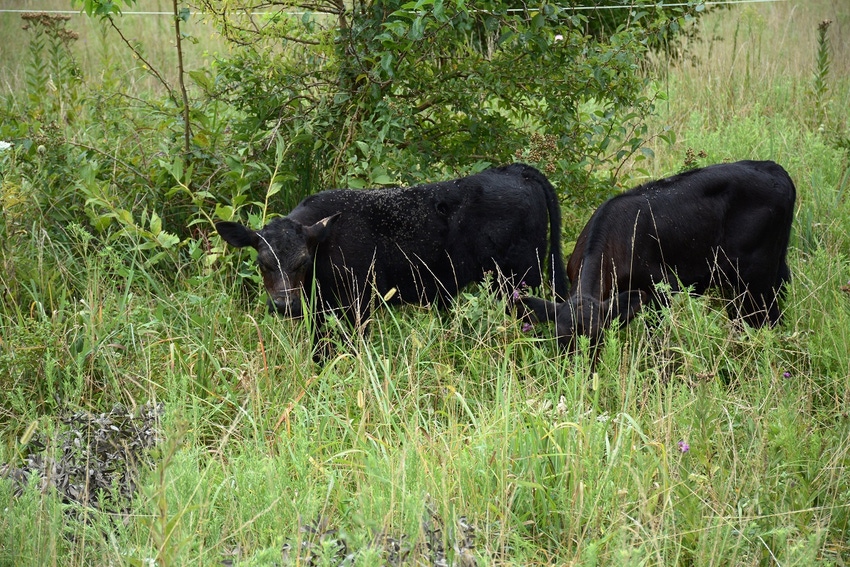
“Lee County Syndrome” was a very common diagnosis at Auburn University Veterinary College when I was stationed there in the mid 1970s. Up at Columbia, Missouri, at the vet school I heard they termed it “High Trough Disease.”
Wherever you locate, there are two things to remember about this syndrome: Limit or restrict nutrition in a temperate country on short grass for extended periods and you’ll have clinical internal parasite (worm) problems. That's what it was.
Of course, an inch per week of moisture will sure grow grass if you get sunshine in a non-frigid country. The lush short grass will also harbor bunches of infective worm larvae. Ostertagia (brown stomach worm) is by far No. 1, but Haemonchus and Cooperia, as well as many other species will show up in high volumes. Haemonchus is a big-numbers bug and is a bloodsucker. It makes big hits on goats that are forced to graze short grass. The Haemonchus female can produce 5,000 eggs daily as compared to a few hundred eggs daily for Ostertagia.
I routinely ate my midday sandwich in the Auburn vet school’s postmortem room back in 1974-1975. Cattle were real cheap and lots of little bovine girls were wintered in the piney woods of east Alabama. The National Research Council’s (NRC) minimum ration standards were far removed from the daily intake for many of the local (Lee County) cattle. Several fatalities made it to the autopsy floor nearly every day starting in mid- to late-January and extending thru mid-April. Some of these producers didn’t feed hay or supplement, but they needed too. You Midwest producers would likely laugh at eastern Alabama quality hay back in those days. Worn out cotton ground was the norm.
Internal parasitism and lack of nutrition are a sum of one plus one equals three. The two can sure take out the bottom 20% of the herd when a few cold fronts are behind the cattle and number four, five or six is on top of them.
By the way, the Jersey and Jersey-cross cows of the South were often capable of losing down to the hide and bone (a body condition score of 2) in the winter and breeding back in early- to mid-May as soon as they started adding flesh. Newer model Jerseys are bigger and have lost much of this ability. This set them to calve in late February to early March; not my recommendation.
When we think of internal parasitism we need to remember several important factors.
Year-around planning of the graze.
Fall and winter body condition scores.
ID and culling of the right (maybe the wrong) cattle. Don’t forget the 80:20 rule (20% of the cattle have 80% of the problems and need to become Big Macs).
Keep pastures clean the majority of the decade. Multiple annual grazings (three or more) is generally a minus. It takes three things to clean a pasture: (1) 70 days with good sunshine (2) lots of plant diversity and healthy soil (3) tall, recovered plants.
Study and learn and observe the natural model truths.
Remember that cattle on a high plane of nutrition are seldom infected clinically with worms. It takes about 200 to 300 worms to stimulate and keep the immune system up to snuff. Also remember that most pastures require some abuse and “muddied up” every few years. Short-term stress with some limitations is good for all systems. At least 15% of all natural systems are destructive in nature. The devil has a purpose in the Lord’s plan.
Consider these following five facts about worms and don’t forget:
Short grass (below 8-10”) and short rotations and set stocking are parasite friendly and parasite productive.
Tall diverse pastures loaded with forbs and brush and completely recovered are parasite unproductive. Note, I did not say worm free.
Cattle should be highly worm resistant by 18 months of age.
Hiding the problem by throwing dollars out the window on chemical control does not work and leads to system breakdown.
Pastures will clean up in 10 weeks under most situations. This is due mostly to sunlight intensity and forage growth and diversity. Fast rotation and fast turnaround on a regular basis are an attempt at suicide and may likely be worse than set stocking from a parasite standpoint.
A pair of ear notchers might argumently be a beef producers best friend. Anytime we chemically worm a cow or long yearling we would be well served to notch the ear tag or ear of the animal and follow through with a favor to the ranch. That favor is to cull the lady in the near future.
I don’t make a habit of giving out warranties that I may later be forced to back up. But I will guarantee that the Designer did not create parasites to decrease your profitability or drive you out of business. Parasites are part of His design to keep us from killing His range.
We routinely hard graze and muddy up a bunch of our pastures in late winter and early spring in order to open the forage canopy for summer growth of higher-energy tall, medium and short warm-season grasses, legumes and forbs. Following that work out we routinely move the cattle to pastures that are full of plant diversity and growing fast. We also add up to eight ounces of apple cider vinegar per 1,000 pounds of body weight per day to the drinking water or the supplement for five to seven days. This tends to clean up parasitism.
Think about it and respond to His model. I promise you’ll have milder winters with earlier and later grasses.
About the Author(s)
You May Also Like






